|
|
 |
|
Calanoida ( Order ) |
|
|
|
Diaptomoidea ( Superfamily ) |
|
|
|
Pontellidae ( Family ) |
|
|
|
Labidocera ( Genus ) |
|
|
| |
Labidocera bengalensis Krishnaswamy, 1952 (F,M) | |
| | | | | | | Syn.: | Labidocera minuta : Greenwood, 1979 (p.101, figs.F, M, Rem.); [after Jeong & al. (2009, p.519)] | | | | Ref.: | | | Krishnaswamy, 1952 (p.321, figs.F,M); Silas & Pillai, 1973 (1976 ) (p.774, 802, Rem., figs.F,M); Goswami & Goswami, 1979 a (p.259, figs. caryotypes); Mulyadi, 2002 (p.55, figs.F,M, Rem.); Othman & Toda, 2006 (p.309, F,M); Phukham, 2008 (p.79, figs.F,M); Al-Yamani & al., 2011 (p.66, figs.F,M) |  issued from : E.G. Silas & P.P. Pillai in J. mar. biol. Ass. India, 1973 (1976), 15 (2). [p.803, Fig.13]. Female (from Gulf of Manaar): a, urosome (lateral right side); b, rostrum (anterior view); c, P5. Nota: Head anteriorly squarly rounded. Dorsal eye lenses prominent. Caudal rami asymmetrical, left ramus slightly longer and broader. A1 22-segmented. The right posterior corner of Th5 has a lobular projection which can be clearly seen when viewed laterally, this lobe adds to the slight asymmetry in the posterior corners of the last thoracic segment. Male: d, 5th metasomal somite and urosome (dorsal, part); e, right A1 (geniculate part); f, A1 (part, segment 22, enlarged); g, P5. Nota: Right A1 geniculate, segments 18 and fusion segments 19-21 carrying villiform and coarse, denticulated teeth respectively, segment 22 distally produced into a spinous structure. Caudal rami symmetrical
Scale as in Calanopia minor.
|
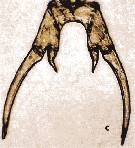 issued from : Y. Al-Yamani, V. Skryabin, A. Gubanova, S. khvorov & I. Prusova in Marine Zooplankton Prarctical Guide for the Northwestern Arabian Gulf, 2, 2011 [p.193 c]. Female: P5.
|
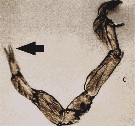 issued from : Y. Al-Yamani, V. Skryabin, A. Gubanova, S. khvorov & I. Prusova in Marine Zooplankton Prarctical Guide for the Northwestern Arabian Gulf, 2, 2011 [p.67, Fig.194 c]. Male: P5 (arrow indicates left P5 terminal segments).
|
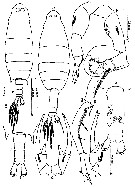 issued from : Mulyadi in Treubia, 2002, 32; [p.57, Fig.16]. Female (from Indonesian waters): a, habitus (dorsal); b, metasomal somite 5 and urosome (ventral); c, P5; d, left P5. Male: e, habitus (dorsal); f, metasomal somite 5 and urosome (dorsal); g, geniculate region of right A1; h, P5. Nota: The specimens differ from the previous descriptions of L. bengalensis by the presence of 2 outer spines on exopod of P5 in the female; the presence of 3 distal processes on exopod 2 of left P5, and 1 long and plumose proximal seta on exopod 2 of right P5 in the male.
|
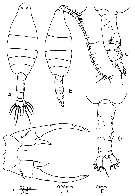 issued from : B.H.R. Othman & T. Toda in Coastal Mar. Sc., 2006, 30 (1). [p.310, Fig.8]. Female (from Sister\"s Island, Singapore): A-B, habitus (dorsal and lateral, respectively); C-D, posterior part of prosome (lateral and dorsal); E, P5. Nota: Prosome to urosome length ratio 2.38 : 1. - Body somewhat broad at 2/3 length of prosome. - Cephalon rounded anteriorly, with lateral hooks. - Prosome rounded at posterior. -Urosome 3-segmented. - Genital segment asymmetrical, elongated, longer than urosomite 2, urosomite 3 and caudal rami combined., right margin swollen with a numbers of ventral papillae. - P5 symmetrical, exopod long, slender and bifurcate, 4 times as long as endopod, with 2 outer spines, and 2 unequal apical spines; endopod short, stout and pointed.
|
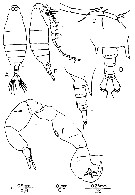 issued from : B.H.R. Othman & T. Toda in Coastal Mar. Sc., 2006, 30 (1). [p.310, Fig.9]. Male (from Sister's Island, Singapore): A-B, habitus (dorsal and lateral, respectively); C, A1 (segments 21-24); D-E, posterior part of prosome and urosome (dorsal and lateral, respectively); F, P5. Nota: Prosome to urosome length ratio 2.99 : 1. - Dorsal eye lenses prominent and contiguous. - Posterolateral end of prosome produced into asymmetrical pointed processes, right process slightly longer extending slightly beyond distal end of genital segment. - Urosome 5-segmented, naked. - Right A1 geniculate, fused segments 17-18 with row of coarse denticles on anterior margin; fused segments 19-21 with villiform denticles from proximal fifth to distal end of its anterior margin, segment 22 prolonged distally into spur-like process. - P5 asymmetrical; right leg ptoximal basis with row of spinules on inner margin and 1 plumose seta on posterior surface, chela well developed, concave surface with 1 blunt process and 1 spiniform seta; exopodal segment 2 bent inwards medially and with 1 marginal transparent flap, proximal inner margin with 1 long and 1 short seta at 1/3 length of segment, and 2 subequal spines at apex; left leg 4-segmented, exopodal segment 1 with distolateral spine, exopodal segment 2 with 3 stout processes distally and 1 seta towards outer margin of inner process, inner margin hirsute.
|
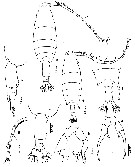 issued from : N. Phukham in Species diversity of calanoid copepods in Thai waters, Andaman Sea (Master of Science, Univ. Bangkok). 2008. [p.160, Fig.34]. Female (from W Malay Peninsula): a, habitus (dorsal); b, urosome (lateral); c, same (dorsal); d, P5. Male: e, habitus (dorsal); f, last thoracic segment and urosome (dorsal); g, segments 21 to 24 of A1; h, P5. Body length after the drawings: F = 1.772 mm; M = 1.297 mm.
|
 Issued from : J.G. Greenwood in Proc. R. Soc. Qd, 1979, 90. [p.102, Fig.5]. As Labidocera minuta. Male (from outer Moreton Bay, SE Quennland, Australia): a, habitus (dorsal); b, lateral cephalic profile; d, P5; e, terminal segments right P5; f, terminal segments left P5. Female: c, urosome (dorsal); g, P5.
|
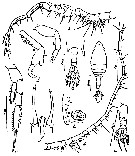 Issued from : S. Krishnaswamy in Rec. Indian Mus., 1952, 49 (3-4). [p.322, Text-Fig. 1]. Female (from Madras, India): a, habitus (dorsal); b, genital segment (ventral); c, abdomen (ventral); d, A1; e, P1; f, P5. Male: g, last thoracic segment and abdomen; h, right A1; j, P5 (R = right leg; L = left leg). Female: Anterior endof cephalosome squared, dorsal lenses very prominent. Rostrum pointed and bent downwards. Lateral hooks present. Abdomen 3-segmented. Genital segment slightly swollen on the right side and bears a number of transparent papillae ventrally. Genital opening paired. Genital segment as long as the combined length of the next segment and anal segments. 2nd abdominal segment produced posteriorly on the left side. Caudal rami symmetrical, each ramus bearing 5 setae and 1 small bristle. A1 22-segmented (segments between 3 and 5 not very clear. Male: Right posterior corner of the cephalothorax produced acutely. Abdomen 5-segmented. Anal segment very short being only half as long as the previous segment. Right A1 17-segmented clearly seen, geniculate ( 3rd segment indistinctly divided appears to consist of 4 fused segments, 6th again indistinctly divided into 2, bringing th total to 21 segments); hinge lies between the 13th and 14th segments, inner margins serrate; the inner end of the 15th segment produced into a toothed spinous process as long as the succeeding segment. A2, mouth parts and P1 as in the female. P5 prehensile; Right leg 3-segmented : a stout basal segment, whose outer margin is swollen, a similar 2nd segment whose inner edge is produced and which carries 1 spine on the inner side, and a terminal, stout, claw-like segment which carries 4 short spines; Left leg 4-segmented: basal segment stout, 2nd segment nearly as long as the 1st and carries 1 spine on its outer side, 3rd segment whose distal end is produced, bears spinules on the inner side, and the terminal segment is slender and claw-like.
| | | | | Compl. Ref.: | | | Krishnaswamy, 1953 (p.134); Ganapati & Shanthakumari, 1962 (p.9, 15); Madhupratap & Haridas, 1986 (p.105, tab.1); Othman & al., 1990 (p.561, 564, Table 1); Mauchline, 1998 (tab.8); Rezai & al., 2004 (p.489, tab.2); Cornils & al., 2010 (p.2076, Table 3) | | | | NZ: | 3 | | |
|
Distribution map of Labidocera bengalensis by geographical zones
|
| | | | | | | Loc: | | | NW Arabian Gulf, N Indian, Laccadive Is., India (Lawson's Bay, Madras, Krusadai), Andaman Sea, W Malay Peninsula, Indonesia-Malaysia (Strait of Malacca, Sunda Strait, Jakarta Bay, N Java coast, Lombok Is., SW Celebes), Australia (G. of Carpentaria, Moreton Bay) | | | | N: | 12 | | | | Lg.: | | | (256) F: 1,68-1,41; M: 1,26-1,09; (461) F: 1,4; M: 1,18; (1085) F: 1,5-2,0; M: 1,3-1,6; (1086) F: 1,6-1,96; M: 1,4-1,64; (1087) F: 1,4-1,5; M: 1,09-1,25; {F: 1,40-2,0; M: 1,09-1,64} | | | | Rem.: | epipelagic. Neritic.
After Krishnaswamy (1952, p.323) the female closely approaches L. brasiliensis Farran in the stucture of P5, but differs in having the posterior corners of the cephalothorax rounded, in the asymmetrical genital segment with the tubercles and in the squared anterior end of the cephalothorax. The male is closely allied to L. minuta Giesbrecht, but differs from it in the structure of the posterior corners of the cephalothorax and P5.
Silas & Pillai (1973, p.803) note some discrepancies between the description and drawings of this species given by Krishnaswamy (1952).
For Mulyadi (2002, p.56) the species belongs to L. minuta-Group.
For Othman & Toda (2006, p.310) this species is often mistaken for L. minuta in the general shape and size of both sexes.
For Jeong & al. (2009, p.518) this species is closely related to L. minuta, but can be distinguished (see Remaks in L. minuta) | | | Last update : 25/10/2015 | |
|
|
 Any use of this site for a publication will be mentioned with the following reference : Any use of this site for a publication will be mentioned with the following reference :
Razouls C., Desreumaux N., Kouwenberg J. and de Bovée F., 2005-2025. - Biodiversity of Marine Planktonic Copepods (morphology, geographical distribution and biological data). Sorbonne University, CNRS. Available at http://copepodes.obs-banyuls.fr/en [Accessed August 16, 2025] © copyright 2005-2025 Sorbonne University, CNRS
|
|
 |
 |












